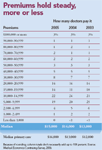Article
Malpractice insurance: Better news? More choices?
Author(s):
As rates stabilize or even drop, doctors are rethinking their insurance options.
After years of enduring sky-high malpractice rates and a shrinking number of carriers, doctors in many parts of the country are beginning to find some relief. "The trend is in physicians' favor right now," says Philip Reischman, president and CEO of Gallagher Healthcare Insurance Services, headquartered in Houston.
The numbers tell the story. In 2004, medical malpractice premiums rose only 5.5 percent, a full eight points lower than the previous year's 13.5 percent increase. Last year, the rate of increase continued to drop, with premiums rising a mere 0.5 percent over 2004 levels, according to A.M. Best, the insurance rating service. That downward trend is likely to continue, at least for a while.
Indeed, with many companies now approaching "rate adequacy" (insurance lingo for rates that cover losses and expenses, and add to surplus), the industry experts at A.M. Best say that the promise of strong profits is causing more carriers to enter the market and that, in turn, is fueling increased competition. Already this year, that competition has prompted prices in some areas to drop even further. (In September, for instance, The Doctors Company, a leading physician-owned med-mal insurer, became the first company in Georgia to file a rate reduction.)

For such physicians, talk of trends moving in doctors' favor has got to seem like so much pie in the sky. Still, if what industry watchers say is true, those trends are real, and could even end up affecting hard cases like Illinois.
With that in mind, we asked several experts to tell us about the coverage decisions doctors are making-and should be making-in today's changing market.
Standing pat with lower limits
For most doctors across the country, $1 million per incident/$3 million aggregate coverage is still the norm, according to the Medical Economics 2006 Continuing Survey. (For more survey data, see the table.)
But during the worst days of the hard insurance market, cost-conscious doctors in certain states-Texas and Florida, for example-lowered their policy limits below this norm, sometimes significantly below. "During the hard market, it wasn't unusual for doctors in Texas to carry $200,000/$600,000 coverage or even $100,000/$300,000," says Keane.
Today, many of these doctors are standing pat, despite the trend toward rates that are stabilizing and, in some places, even coming down. "Most of them at this point have adjusted to the lower limits," says Reischman. "And while news of a big verdict or settlement might scare them, they're prepared to take on the additional risk given the continuing price differences between their lower coverage and the standard $1million/$3 million policy."





